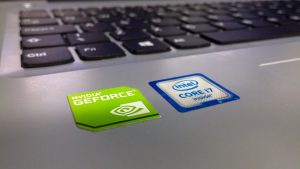Signs of a Failing Graphics Card
A graphics card is an essential component in any computer system, responsible for rendering images and videos on your monitor. Like any other hardware component, graphics cards can deteriorate over time and eventually fail. It is crucial to understand the signs that indicate a failing graphics card to avoid further damage and ensure the proper functioning of your system. Here are some common signs to look out for:
-
Visual Artifacts and Glitches
One of the first signs of a failing graphics card is the appearance of visual artifacts and glitches on your screen. These can manifest as random pixels, lines, or blocks, distorted colors, or screen flickering. If you notice these abnormalities consistently, it may indicate a hardware problem with your graphics card.
-
Overheating and Fan Issues
Graphics cards generate a significant amount of heat during operation, and proper cooling is essential to maintain their performance. If your graphics card is overheating or if you notice issues with the fan not spinning correctly, it could be a sign of a failing graphics card. Overheating can cause system instability and may result in permanent damage if not addressed promptly.
-
Screen Freezes and Crashes
If your computer frequently freezes or crashes while performing graphic-intensive tasks, such as gaming or video editing, it could be due to a failing graphics card. A deteriorating graphics card may struggle to handle the workload, leading to system instability and crashes.
-
Performance Degradation
If you notice a sudden drop in the performance of graphic-intensive applications or games, it could be a sign of a failing graphics card. Slow rendering, low frame rates, and overall sluggishness can indicate that your graphics card is struggling to keep up with the demands of the software.
-
Blue Screen of Death (BSOD) Errors
Experiencing Blue Screen of Death (BSOD) errors, especially while running graphic-intensive tasks, can be indicative of a failing graphics card. These errors generally occur when the graphics card encounters a critical hardware or driver issue.
-
Strange Noises
If you hear strange noises, such as grinding, buzzing, or whining, coming from your graphics card or computer, it could suggest a failing fan or a malfunctioning GPU. These noises should not be ignored, as they could be a sign of impending hardware failure.
-
Driver Errors and System Instability
A failing graphics card can cause various driver errors and overall system instability. You may experience frequent crashes, software freezes, or error messages related to your graphics card drivers.
-
System Won’t Boot or Display Anything
If your system fails to boot, and you’re not seeing anything on your monitor, it could be a sign of a severe graphics card issue. Ensure that all connections are secure, but if the problem persists, it may be due to a failing graphics card.
-
Graphic Intensive Applications Malfunctioning
If graphic-intensive applications start to malfunction or crash consistently, even after reinstalling them or updating drivers, it could indicate that your graphics card is experiencing hardware issues.
-
Random Black Screens
If your screen occasionally goes black for a few seconds or longer, regardless of the application you are running, it could indicate an underlying problem with your graphics card. Random black screens are a red flag for potential graphics card failure.
If you observe any of these signs, it is advisable to take immediate action to prevent further damage to your graphics card and to ensure the smooth operation of your system. Promptly addressing a failing graphics card can save you from unexpected system crashes, data loss, and the need for costly repairs or replacements.
Visual Artifacts and Glitches
Visual artifacts and glitches are some of the most noticeable signs of a failing graphics card. If you start noticing strange abnormalities on your screen, such as random pixels, lines, or blocks appearing out of nowhere, distorted colors, or screen flickering, it could indicate a hardware problem with your graphics card.
These visual anomalies can occur during regular computer usage or when performing graphic-intensive tasks, such as gaming or multimedia editing. You may notice these artifacts and glitches consistently or intermittently, but they should not be disregarded as normal behavior.
When your graphics card is in a healthy state, it accurately renders images and videos, ensuring a smooth and visually pleasing experience. However, as it begins to fail, it may struggle to process the data correctly, resulting in the appearance of anomalies on your screen.
These visual issues can be frustrating and disruptive, making it difficult to use your computer effectively. Not only do they detract from the overall user experience, but they can also be a precursor to more serious problems if left unaddressed.
If you notice visual artifacts and glitches, it is crucial to troubleshoot the issue promptly. Start by updating your graphics card drivers to the latest version, as outdated or incompatible drivers can sometimes cause these problems. If that doesn’t resolve the issue, try reseating the graphics card in its slot and ensuring that all connections are secure.
If the visual artifacts and glitches persist even after driver updates and reseating the card, it is highly likely that your graphics card is failing and needs to be replaced. Consulting with a professional technician or contacting the manufacturer’s support team can help you determine the best course of action.
Experiencing visual artifacts and glitches is a clear indicator that your graphics card is not functioning optimally. Ignoring these signs may lead to further damage and potentially render your computer unusable.
Take action as soon as possible to address this issue, ensuring the smooth operation of your computer and preserving the quality of your visual experience.
Overheating and Fan Issues
Overheating and fan issues are common signs of a failing graphics card. Graphics cards generate a significant amount of heat during operation, and proper cooling is vital to maintain their performance and longevity. When the cooling system fails to effectively dissipate heat, it can lead to overheating, which negatively impacts the graphics card’s functionality.
If you suspect that your graphics card is overheating, there are a few indications to look out for. The first and most obvious sign is an unusually hot graphics card. You may notice that the card feels excessively hot to the touch, particularly in the area near the GPU (Graphics Processing Unit).
Another sign of overheating is when your computer starts experiencing sudden system crashes or shutdowns while executing graphic-intensive tasks. The graphics card may get overwhelmed by the workload, causing it to overheat and trigger a protective mechanism that shuts down the system to prevent damage.
Fan issues can also contribute to overheating. Graphics cards incorporate fans to cool down the GPU and other components. If you notice that the fan on your graphics card is not spinning at all or is spinning erratically, it is a clear indication of a problem. A failing fan cannot effectively dissipate heat from the graphics card, leading to increased temperatures and performance issues.
To address overheating and fan issues, start by cleaning the graphics card and its fan. Dust and debris accumulation can hinder airflow and cause cooling problems. Use compressed air or a soft brush to gently remove any dust buildup on the fan blades and heat sink. Ensuring proper airflow in your computer case by cleaning other components and making sure that cables are well-organized can also help combat overheating.
If cleaning doesn’t resolve the overheating issue, check if the fan’s power connection is secure. Sometimes, a loose or faulty connection can lead to fan malfunctions. If the fan continues to exhibit issues, it may be necessary to replace it or seek professional assistance.
Overheating can damage not only the graphics card but other sensitive components as well. Continuous exposure to high temperatures can shorten the lifespan of the card and cause permanent damage. Therefore, it is crucial to address overheating and fan issues promptly to prevent further damage and ensure the proper functioning of your system.
Screen Freezes and Crashes
If you frequently experience screen freezes or crashes while using your computer, it could be a sign of a failing graphics card. Screen freezes occur when your computer becomes unresponsive, forcing you to restart or shut it down manually. These freezes can happen randomly or when performing graphic-intensive tasks, such as gaming or video editing.
The primary cause of screen freezes and crashes related to a failing graphics card is the card’s inability to handle the workload. As the graphics card deteriorates, it may struggle to process the information required for rendering graphics on your screen. This results in system instability, leading to freezes and crashes.
When your computer freezes, it may indicate that the graphics card has reached its maximum capacity and is unable to handle the demand. This could be due to hardware defects, outdated drivers, or insufficient power supply to the graphics card.
If you frequently experience screen freezes and crashes, start by updating your graphics card drivers to the latest version. Outdated or incompatible drivers can cause compatibility issues and lead to system instability. Restart your system after updating the drivers and observe if the freezes persist.
If updating the drivers does not resolve the issue, it is essential to ensure that your power supply is adequate for your graphics card. Some high-performance graphics cards require additional power connectors and may strain your power supply if not properly connected or if the supply is insufficient. Check the specifications of your graphics card and ensure that your power supply can handle its requirements.
If the screen freezes and crashes continue despite driver updates and proper power supply, it is likely that your graphics card is failing. Continuing to use a failing graphics card can risk further damage to your system and potentially result in data loss. In such cases, seeking professional assistance or replacing the graphics card is recommended.
Screen freezes and crashes can be frustrating, interrupting your work or gaming sessions. They are clear indicators that something is wrong with your graphics card. Addressing the issue promptly will help prevent further disruptions and ensure the smooth operation of your computer.
Performance Degradation
If you notice a sudden drop in the performance of graphic-intensive applications or games, it could be a sign of a failing graphics card. Performance degradation can manifest as slow rendering, low frame rates, and overall sluggishness when using graphic-intensive software.
A healthy graphics card is designed to handle the demands of graphic-intensive tasks smoothly, providing seamless visuals and smooth gameplay. However, as a graphics card ages or experiences hardware issues, it may struggle to keep up with the demands placed on it, resulting in performance degradation.
One common symptom of performance degradation is decreased frame rates while playing games. You may notice that games that used to run smoothly suddenly lag or stutter. The movements on the screen may appear jerky or delayed, making gameplay frustrating and unenjoyable.
When using graphic-intensive applications, such as video editing software, you may experience slow rendering times. Tasks that used to complete quickly may now take significantly longer, affecting your productivity and workflow.
In addition to slower performance, you may also notice visual quality degradation. Graphics may appear pixelated or blurry, textures may not render properly, or colors may appear washed out. These visual anomalies can be a result of a failing graphics card’s inability to accurately process and render the visuals.
To determine if your graphics card is causing performance degradation, start by updating your drivers to the latest version. Outdated drivers can sometimes result in performance issues. After updating the drivers, test the performance of your graphics card using benchmarking applications or by running graphic-intensive software. If the performance remains subpar, it is likely that your graphics card is failing.
In some cases, performance degradation can be attributed to other factors, such as insufficient RAM, a slow processor, or software conflicts. However, if you have ruled out these possibilities, and the performance issues persist, it is advisable to seek professional assistance or consider replacing your graphics card.
Keep in mind that performance degradation may happen gradually over time, making it difficult to notice until it becomes significant. Regularly monitoring the performance and benchmarks of your graphics card can help you identify any decline in performance and take appropriate action.
Don’t let performance degradation go unnoticed, as it can impact both your gaming and productivity experiences. Ensure that your graphics card is functioning optimally to enjoy smooth and visually stunning applications and games.
Blue Screen of Death (BSOD) Errors
Experiencing the dreaded Blue Screen of Death (BSOD) errors can be a clear indication of a failing graphics card. The Blue Screen of Death is a critical error screen that appears when the operating system encounters a fatal hardware or software issue.
BSOD errors caused by a failing graphics card typically occur during graphic-intensive tasks, such as gaming or multimedia editing. These errors can manifest as a blue screen with accompanying error codes and messages, indicating a problem with the graphics card or its drivers.
When a graphics card is failing, it may encounter issues with rendering graphics or handling the heavy workload. This can lead to system instability, resulting in BSOD errors as a failsafe mechanism to prevent further damage.
BSOD errors related to a failing graphics card often have error codes specific to graphics-related issues, such as “VIDEO_TDR_FAILURE,” “THREAD_STUCK_IN_DEVICE_DRIVER,” or “ATIKMDAG.SYS.” These codes provide insight into the nature of the problem and help in troubleshooting.
To address BSOD errors caused by a failing graphics card, start by updating your graphics card drivers to the latest version. Outdated or incompatible drivers can cause conflicts and lead to system instability. Updating the drivers may resolve the issue and prevent further BSOD errors.
If updating the drivers doesn’t resolve the problem, you can try removing and reinstalling the graphics card. Ensure that all connections are secure and clean any dust or debris from the card and its slot.
If the BSOD errors persist, it is highly likely that your graphics card is failing and needs to be replaced. Consult with a professional technician or contact the manufacturer’s support for further assistance and guidance.
Ignoring BSOD errors can result in system crashes, data loss, and potential damage to other components. It is crucial to address these errors promptly and take appropriate measures to ensure the stability and performance of your system.
Remember to document any error codes or error messages you encounter, as they can provide important information to diagnose the underlying issue. This documentation can also prove helpful when seeking professional help or contacting technical support.
Experiencing frequent BSOD errors is a strong indication of a failing graphics card. Act promptly to resolve this issue and maintain the overall stability and usability of your computer.
Strange Noises
If you hear strange noises emanating from your computer, particularly from your graphics card, it could be a sign of a failing component. Unusual noises such as grinding, buzzing, or whining can indicate a problem with the fan, GPU, or other components within the graphics card.
A graphics card typically incorporates a fan to cool down the GPU and prevent overheating. If you hear grinding or buzzing noises, it may indicate that the fan is encountering difficulties or is about to fail. The fan’s blades may be hitting something or rubbing against a component, causing the unusual sound.
Whining noises from the graphics card can also indicate a problem with the GPU itself. This high-pitched noise, often described as coil whine, can occur when electrical components within the GPU vibrate at certain frequencies. While coil whine doesn’t necessarily mean the graphics card is failing, it can be an early warning sign of potential issues.
It’s worth noting that some graphics cards may emit a low humming noise during normal operation. However, if the noise becomes pronounced, persistent, or changes in tone, it’s likely indicative of a problem.
When you hear strange noises coming from your graphics card, it is essential to address the issue promptly. Start by ensuring that the noise is indeed coming from the graphics card and not from a different component in your system. Open up your computer’s case and listen closely to pinpoint the source of the noise.
If the noise is coming from the graphics card, check for any obstructions around the fan, such as dust or cables. Clearing these obstructions may resolve the issue. Additionally, ensure that the fan is securely connected and functioning correctly.
If the strange noises persist, it is advised to contact a professional technician or the manufacturer’s support team for further assistance. They can provide guidance on whether the graphics card needs to be repaired or replaced.
It’s important not to ignore strange noises emanating from your graphics card, as they can indicate potential hardware problems. Addressing the issue promptly can help prevent further damage and ensure the optimal performance and lifespan of your graphics card.
Driver Errors and System Instability
Driver errors and system instability are common signs of a failing graphics card. Graphics card drivers are essential software components that enable communication between the operating system and the graphics card hardware. When the graphics card starts to fail, it can result in various driver errors and overall system instability.
One of the first signs of a failing graphics card is encountering frequent driver errors. These errors can manifest as error messages indicating a problem with the graphics card, such as “Display driver stopped responding and has recovered” or “NVIDIA/AMD driver has encountered a problem.”
System instability is another indication of a failing graphics card. You may experience random system crashes, freezes, or software failures. These issues can occur when the graphics card is unable to handle the demands placed on it or when the drivers become corrupted due to hardware malfunctions.
Driver errors and system instability can disrupt your workflow, cause data loss, and impact the overall performance of your computer. It’s crucial to address these issues promptly to prevent further damage and ensure a stable computing experience.
Start by updating your graphics card drivers to the latest version. Outdated or incompatible drivers can lead to conflicts and errors. Visit the manufacturer’s website or use driver update software to ensure you have the most up-to-date drivers installed.
If updating the drivers doesn’t resolve the issue, try reinstalling them. Completely uninstall the current drivers and then install the latest version from the manufacturer’s website. This can help resolve any corrupted driver files that may be causing the errors and instability.
If driver updates and reinstalls do not alleviate the problem, it is likely that your graphics card is failing. In such cases, it may be necessary to seek professional assistance or consider replacing the graphics card with a new one.
Remember to back up your important data regularly, as system instability caused by a failing graphics card can result in unexpected crashes or data loss. Additionally, ensure that you have a stable power supply to prevent voltage fluctuations that could affect the graphics card’s performance.
Don’t overlook driver errors and system instability, as they can point to underlying hardware issues with your graphics card. Taking action early on can help prolong the life of your system and maintain its stability and performance.
System Won’t Boot or Display Anything
If your computer fails to boot or doesn’t display anything on the screen, it could indicate a severe problem with your graphics card. The graphics card is responsible for generating the display output, and when it fails, it can prevent your system from starting up properly.
There are several reasons why your system may not boot or display anything due to a failing graphics card. It could be due to hardware defects, incompatible drivers, or issues with the connections between the graphics card and other components.
When you encounter this issue, start by checking the connections between the graphics card and the monitor. Ensure that the cables are securely connected to both the graphics card and the monitor. Sometimes, loose connections can prevent the display signal from reaching the monitor, resulting in a blank screen.
If the connections are secure, but you still see no display, try connecting your monitor to a different source, such as an integrated GPU or a different computer. This will help determine if the issue lies with the graphics card or the monitor itself.
If you have confirmed that the graphics card is the cause of the problem, you can try resetting the card. Power down your computer, unplug it from the power source, and remove the graphics card. Wait for a few minutes, then reseat the graphics card firmly into its slot. Reconnect all the necessary power cables and try booting the system again.
If none of these steps resolve the issue, it is likely that your graphics card is faulty and needs to be replaced. Even if the rest of your system appears to be functioning correctly, a failing graphics card can prevent the system from booting or displaying anything.
If you are not familiar with hardware troubleshooting, it is advisable to seek professional assistance. A technician can help diagnose the problem accurately and guide you through the process of replacing the graphics card if necessary.
Experiencing a system that won’t boot or display anything can be frustrating and worrisome, but it is important to remain calm and troubleshoot the issue step by step. Identifying the cause of the problem will help you take appropriate action and get your system up and running smoothly again.
Graphic Intensive Applications Malfunctioning
If you experience frequent malfunctions or crashes when using graphic-intensive applications, such as 3D modeling software or advanced video editing tools, it could be a sign of a failing graphics card. Graphic-intensive applications put a heavy load on the graphics card, and if it is struggling to keep up, you may encounter various issues.
When a graphics card is failing, it may have difficulty processing the complex calculations and rendering required by these applications. As a result, you may experience slowdowns, glitches, crashes, or even complete software failures.
Common signs that your graphics card is the cause of these malfunctions include freezes or crashes that occur specifically when using graphic-intensive applications, abnormal artifacting or graphical glitches within the application’s interface or renderings, or error messages directly related to the graphics card.
If you encounter these problems, start by updating your graphic card drivers to the latest version. Outdated or incompatible drivers can cause compatibility issues and lead to malfunctions. Ensure that you choose the appropriate driver for your graphics card model and system configuration.
Additionally, check if the system requirements of the graphic-intensive applications are within the capabilities of your graphics card. If your graphics card falls short of the minimum requirements, it may struggle to handle the application’s demands, leading to malfunctions. In such cases, upgrading to a more powerful graphics card may be necessary.
It is also important to monitor the temperatures of your graphics card while running these applications. Overheating can cause performance issues and crashes. Ensure that your computer has adequate cooling, and consider cleaning any dust buildup on your graphics card’s fan and heat sink.
If updating drivers, checking system requirements, and addressing cooling issues does not resolve the malfunctions, it is likely that your graphics card is failing. At this point, it may be necessary to consult with a professional technician or consider replacing the graphics card with a more reliable and capable one.
Remember, graphic-intensive applications require a strong graphics card to run smoothly and efficiently. Malfunctions and crashes can hinder your productivity and potentially result in data loss. Don’t ignore these issues, as they may indicate underlying problems with your graphics card.
Addressing the issue promptly will help ensure that these applications perform optimally, delivering the best results without disruptions or failures.
Random Black Screens
If you frequently experience random black screens on your computer, regardless of the application you are running, it can be a strong indicator of a failing graphics card. Random black screens typically occur when the graphics card encounters issues that prevent it from rendering the display properly.
Random black screens can happen sporadically or become more frequent over time. You may notice the screen go black for a few seconds or longer before returning to normal, or you might need to restart your computer to restore the display.
There are several potential causes for random black screens. It could be due to overheating of the graphics card, compatibility issues with the drivers, hardware defects, or even power supply problems.
Overheating is a common cause of random black screens. When the graphics card reaches excessive temperatures, it may trigger a protective mechanism that shuts off the display to prevent damage. Cleaning the graphics card and ensuring proper airflow in your computer case can help mitigate overheating issues.
Outdated or incompatible graphics card drivers can also contribute to random black screens. Check for and install the latest drivers from the manufacturer’s website to ensure compatibility and resolve any software-related issues.
Hardware defects in the graphics card, such as a faulty GPU or VRAM, can also cause random black screens. These defects may become more apparent when the graphics card is under heavy load. In such cases, replacing the failing graphics card is the most effective solution.
In some instances, random black screens may occur due to power supply issues. If your power supply is unable to provide sufficient and stable power to the graphics card, it can cause intermittent blackouts. Consider upgrading to a higher-wattage power supply to ensure proper power delivery.
Addressing random black screens can be challenging as there can be multiple potential causes. Start by checking for overheating, updating drivers, and ensuring adequate power supply. If the issue persists, it is advisable to seek professional assistance to diagnose and resolve the problem.
Random black screens can be frustrating, disrupting your workflow and causing potential data loss. Ignoring these issues may lead to further damage to your system. Taking appropriate action to address the problem will help maintain the stability and functionality of your computer.

























